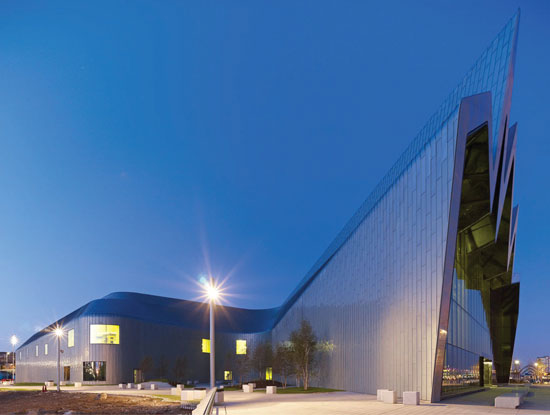
Officially opened in June 2011, the striking Riverside Museum in Glasgow, Scotland, pays tribute to its location in one of Scotland’s key transportation hubs. Glasgow is an intersection point for four motorways and two international airports, and visitors to the museum set off down a tunnel to some 3,000 interactive, hands-on exhibits, including bicycles, cars, trams, buses, locomotives and reconstructed streets of houses. The different exhibition areas are designed to merge into one another to simulate the flow of traffic on nearby roads or along the River Clyde.
Designed by world-renowned architect Zaha Hadid, the soft, flowing lines of the museum’s exterior architecture present an impressive sight. The roof system and façade merge into one element to create intriguing, unique geometries. From inside, visitors can admire the rise and fall of the external roof system, which includes height differences as great as 33 feet.
The façade was built with RHEINZINK® standing-seam titanium zinc, and the roof system received RHEINZINK double standing-seam titanium zinc. To create a seamless transition to the roof system, every profile was individually matched to the building’s curves. About 24,000 panels were produced on-site and tailored. On the roof area, the radii, pitches and material widths varied among profiles, and every panel was cut, formed and seamed by hand.
The roof area has been equipped with interior gutters at its lowest points and covered with perforated standing-seam profiles to protect it from soiling. To ensure reliable drainage, extensive testing was carried out to match the capacity and flow behavior of the gutters to the expected volumes of water.
The building material needs no maintenance because of the material’s patina, which develops during the course of natural weathering and protects it from corrosion. The patina is a layer of zinc carbonate, which regenerates itself. The development of the protective layer is a natural process, which occurs slowly and unevenly depending on rainfall levels, orientation and direction of the roof system. During this phase, light reflections can make the surface appear irregular. This prompted RHEINZINK to develop a unique pickling process for the surface. Because pickling only is designed to modify the color of Riverside Museum to ensure it blends in with its maritime environment, the lifelong protective patina is not affected.
Construction of the Riverside Museum involved installing about 200 tons of RHEINZINK titanium zinc, mostly with strip widths of 575 mm and 675 mm. To match the panels of the complex geometry, strip widths of up to 1,000 mm also were necessary.
The museum is expected to draw an anticipated 800,000 visitors during its first year.
To submit a photo for Close-up, e-mail professionalroofing@professionalroofing.net or mail a photo to Professional Roofing Attn.: Close-up, 10255 W. Higgins Road, Suite 600, Rosemont, IL 60018. Submittals should include a photo, as well as a description or background for the photo. A $100 gift card will be awarded for the photo that is chosen to be featured in Close-up.
COMMENTS
Be the first to comment. Please log in to leave a comment.